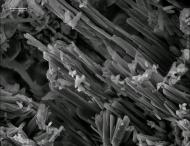Science in our materials
Scientific research enables Lafarge to understand the properties of its products in order to improve their performance and develop even greater innovations.
Using nanotechnology to understand building materials |
|
|
Lafarge R&D teams use sophisticated technology to study the structure of materials at the nanoscale, with almost infinitely small objects that range from 1 to 100 billionths of a meter in size. Nanoscale observation enables us to:
The study of building materials at the nanoscale enables Lafarge to improve the performance of its existing products. It also allows the development of even more sophisticated products offering new possibilities for architects and engineers |
Microstructure of materials"For a long time, we believed that construction materials were homogenous. However, by working at the microscopic level, we have come to realize that they are highly complex and extremely heterogeneous. Today, we use the latest techniques to obtain precious information about the microstructure of materials. Research now occurs at the nano-scale. The challenges this presents are enormous." P. J. M. Monteiro, Head of Structural Engineering, Mechanics and Materials at the University of California at Berkeley. 
|
Environmentally friendly building materials |
|
|
Lafarge also uses scientific research and experimentation to find ways of using fewer natural resources. Lafarge's goals in researching more environmentally friendly products are twofold:
|
|





